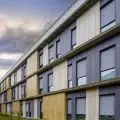moving away from fans and radiators proves possible
{Studio} unveiled Vertikal Nydalen, a multifunctional building with a self-sufficient temperature control system and natural ventilation. Vertikal Nydalen, which officially opened on April 25, 2024, is located in the historic industrial area of Nydalen on the Akerselva River in Oslo.
Over the past few decades, Nydalen has undergone a transformation from a traditional industrial district to a business zone. As the city planned to revitalize the neighborhood and reduce traffic in it, a skyscraper stood on the site of a former parking lot. It houses restaurants on the first floor, offices on the first five floors, and apartments on the remaining floors.
Facade covered with pine wood
Lars Petter Pettersen | © Snøhetta
To preserve view lines, the building was divided into two blocks of different heights, only one of which uses the maximum height ceiling of the plot of 18 stories. Alleys and pedestrian routes have been created around the skyscraper. Inside, the building provides optimal sunlight, while outside it shields from the wind.
Triple zero
According to the triple zero solution principle used, the building requires no energy supply for heating, cooling and ventilation. This was achieved using deep well water, photovoltaic panels, a low-energy thermoregulation system and natural ventilation. The project achieved an overall reduction of more than 50 percent in CO₂ emissions (in material production and transportation) compared to the reference project.
Water and air circulation
Circulating water from geothermal wells in the concrete slabs and clay brick walls cools or heats the building depending on the weather. Heat energy absorbed by the concrete during the day is released at night, thus optimizing the temperature in the high-rise building. Photovoltaic panels on the roof power a heat pump that controls the heating and cooling system.
As architects and members of the construction industry, we have a great responsibility to find viable solutions to the enormous environmental challenges we face today. As part of our office's innovation efforts, we have explored new ways of working through Vertikal Nydalen
says one of the office's founders, Kjetil Trædal Thorsen.
Since traditional ventilation systems in office buildings often require the ceiling to be lowered by up to a meter, a solution that does not use ventilation pipes saves a lot of space - space that is better used for light and openness that can dramatically improve spatial qualities. How were the fans gotten rid of?
The angled façade was designed to create pressure differences that allow air to flow through the building. Air enters through valves in the façade that open and close as needed. When two windows open on different sides of the building, the pressure differential forces air to move through the rooms.
In addition to the obvious environmental benefits, naturally ventilated offices have less need for remodeling and technical maintenance, so such spaces serve longer.
Views from near and far
The facade consists of elements covered with pine planks. The wood was heat-treated, giving it a warm character. Standing out on the wooden surface are 43 slanted balconies finished in steel. Their perforated balustrades and multi-faceted panels capture light from different angles, providing observers with a visual experience that depends on the time of day.
Perforated balcony balustrades
Lars Petter Pettersen | © Snøhetta
The non-traditional structural solutions forced certain consequences in the interior design. The use of finishing materials would negate the impact of the raw concrete and the high ceiling height on the building's thermoregulation system. Therefore, the concrete is exposed as much as possible, with only a thin layer of oak parquet glued to the concrete floor of the apartments. Large windows provide plenty of light (a rarity for new construction) and views of the surrounding area, most of which extend all the way to the Oslo fjord.
An example of the interior of Vertikal Nydalen decorated with minimal finishing materials
Lars Petter Pettersen | © Snøhetta
Scientific advances in construction
The solutions used in Vertikal Nydalen are the aftermath of the work of two research teams supported by the Norwegian Research Council. The first, LowEx, aims to develop new concepts for providing thermal energy in zero-energy and positive-energy buildings, with the ultimate goal of being 2 to 2.5 times more efficient than today. The second interdisciplinary research project, Naturally (Naturligvis), with 13 participants from the Norwegian building industry, focuses on developing new natural ventilation strategies.
The building is a FutureBuilt pilot project certified according to BREEAM NOR (Building Research Establishment Environmental Assessment Method), with Excellent for office space and Very Good in apartments.
Tracking microclimate changes
In order to collect data on the ventilation and temperature of the building, sensors have been deployed in all areas of the building, which will be operational during the life of the skyscraper. In addition, all desks in the office spaces have QR codes that lead to a registration form where both positive comments and criticism can be left. The vents will be programmed to respond to ongoing measurements from sensors and information from building users. Energy use, indoor climate and user satisfaction will be measured as part of the Hybrids research project - an extension of the Naturally project. User experience in terms of thermal comfort and air quality will be monitored as part of the SmartTune project.
Dr. Tor Helge Dokka, Skanska's chief advisor, concludes:
One important question that Vertikal Nydalen can answer is this: can we eliminate 80 percent of the technology in a modern office building and still achieve excellent conditions for its use? Can we omit most of the expensive and complex mechanical solutions and instead build a solid building with solutions that will last for decades while providing thermal comfort and air quality? We believe the answer is yes, and Vertikal Nydalen shows how it can be done.
compiled from author's description Ania Kociucka























